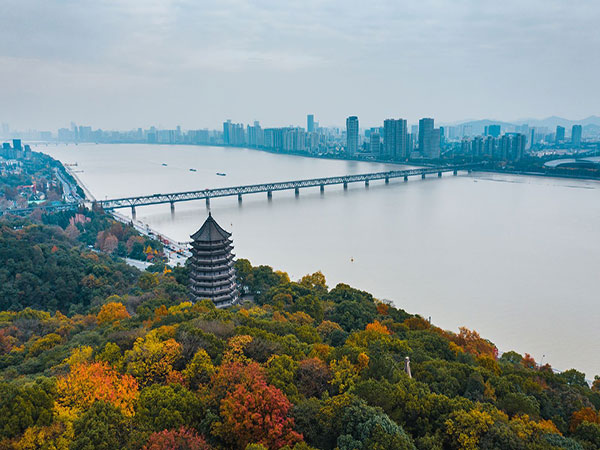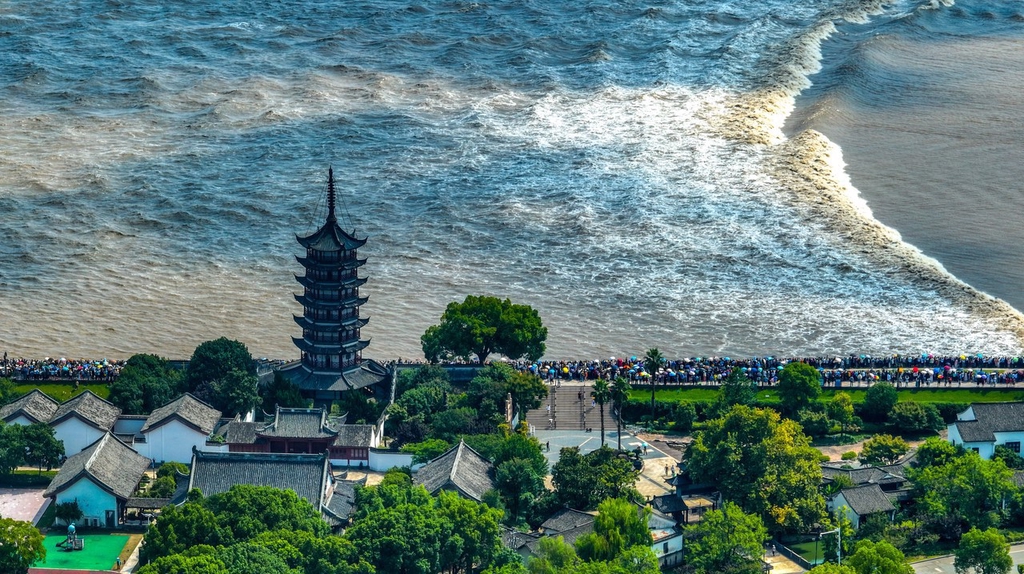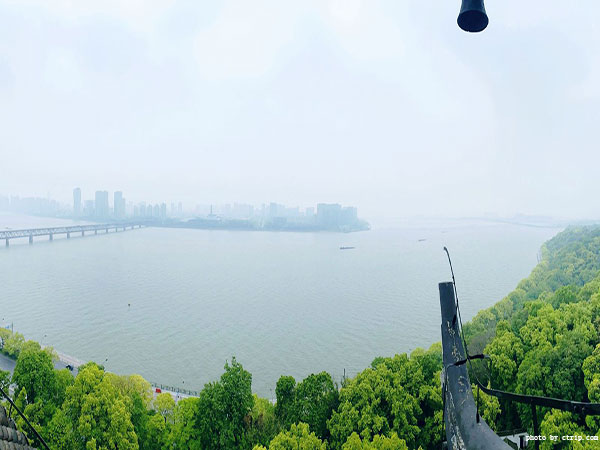Qiantang River Seawall: Where Adventure Meets Tranquility

An Essential Guide to Visiting Qiantang River Seawall
Nestled along the banks of the majestic Qiantang River, the Seawall stands as a remarkable testament to nature’s power and human ingenuity. This iconic structure, spanning several kilometers, is not just a barrier against the surging tides but also a gateway to witnessing one of the world’s most awe-inspiring natural phenomena: the Qiantang River tidal bore. As the river swells and the tide rises, visitors flock to this picturesque site to experience the exhilarating rush of water, where waves can reach heights of up to nine meters.
The Seawall is more than just a prime viewing spot; it is steeped in history, having safeguarded ancient salt merchant towns like Yanguan for over two millennia. Here, the echoes of the past mingle with the vibrant present, creating an atmosphere that is both tranquil and electrifying. From the breathtaking sight of the tidal bore to the rich cultural heritage found in the nearby ancient town, a visit to the Qiantang River Seawall is an unforgettable journey that captures the essence of Jiangnan’s charm.
So whether you’re an avid adventurer, a history enthusiast, or simply seeking a serene escape from the hustle and bustle of urban life, the Qiantang River Seawall promises an experience like no other. Get ready to immerse yourself in the breathtaking beauty and cultural richness that this extraordinary destination has to offer.
In This Guide
- An Essential Guide to Visiting Qiantang River Seawall
- The Rich History and Legends of Qiantang River Seawall
- Main Highlights: What You Absolutely Can’t Miss
- Planning Your Visit: A Practical Guide
- Tickets: Prices, Booking, and Tips
- How to Get There: A Complete Transportation Guide
- Local Cuisine and Accommodation Nearby
- Frequently Asked Questions
- Final Thoughts on Your Trip
The Rich History and Legends of Qiantang River Seawall
The Qiantang River Seawall, a marvel of engineering and history, stretches along the banks of one of China’s most significant waterways. This ancient structure has witnessed the ebb and flow of time for over two millennia, shaping not only the landscape but also the lives of those who inhabit its shores.
The roots of the seawall date back to the Western Han Dynasty (206 BC – 9 AD), when local officials first recognized the need to manage the formidable tides of the Qiantang River. The region is famous for its tidal bore, known as the Silver Dragon Tide, which can reach heights of up to 9 meters. As the river surges, it creates a breathtaking spectacle, drawing crowds of onlookers eager to witness its might. Over the centuries, various dynasties, including the Tang and Song, further enhanced the seawall, reinforcing it against the relentless power of the ocean.
Yanguan Ancient Town, located near the seawall, serves as a testament to the historical significance of this area. It flourished as a salt trading port during the Ming and Qing dynasties, with grand merchant mansions lining its streets. These structures whisper tales of imperial monopolies and prosperous salt merchants who once ruled the trade. The underground salt cellars, which still exist today, tell a story of ingenuity as they safely stored vast quantities of brine, essential for the region’s economy.
Legends abound concerning the Qiantang River and its tides. One captivating story involves Emperor Qianlong, who famously visited the area to marvel at the spectacle of the tides from the Tide-Watching Pavilion. His fascination with the natural phenomenon led to the establishment of the Mid-Autumn Tide Festival, where dragon boat races are held against the backdrop of the thundering waves. This festival, still celebrated today, symbolizes the deep connection between the people and the river, blending tradition with the forces of nature.
The seawall not only serves a practical purpose but also represents a living heritage. Families in Yanguan continue to practice traditional salt evaporation methods, harking back to the Yuan Dynasty. As you stroll along the seawall, you may encounter these “Last Salt Masters,” keeping the ancient craft alive in an ever-modernizing world.
Visiting the Qiantang River Seawall is more than just a sightseeing excursion; it’s a journey through time. Whether you stand in awe of the towering tides or explore the quaint streets of Yanguan, you’ll find yourself immersed in a rich tapestry of history, culture, and nature. As the tides roar and recede, they carry with them centuries of stories waiting to be discovered.

Qiantang River Seawall.
Main Highlights: What You Absolutely Can’t Miss
When you visit the Qiantang River Seawall, you’re stepping into a realm where nature’s grandeur and historical significance converge magnificently. Here are the main highlights that promise an unforgettable experience.
Experience the Tidal Bore
Witness the Qiantang Tide
The Qiantang River is renowned for its tidal bore, one of the largest in the world. As the tide rushes in, it creates an awe-inspiring spectacle that draws both locals and travelers alike. Head to the Tide-Watching Pavilion, a historic vantage point that once captured the gaze of Emperor Qianlong. Today, it offers breathtaking views and modern amenities like AI tide predictions to enhance your experience. Be sure to check the tide schedule to catch this natural wonder at its peak!
Explore Yanguan Ancient Town
Wander through History
Just a stone’s throw away from the Seawall, Yanguan Ancient Town beckons with its charming streets and rich history. This quaint Jiangnan gem, over 2,000 years old, was once a bustling hub for salt merchants. Marvel at the well-preserved Ming and Qing dynasty architecture, where every building tells a story of imperial trade and local culture.
Meet the Last Salt Masters
In Yanguan, you can still encounter the last salt masters who utilize traditional Yuan Dynasty techniques to evaporate seawater. This living heritage is a fascinating glimpse into the past and a testament to the resilience of local craftsmanship.
Celebrate the Mid-Autumn Tide Festival
Join the Festivities
If your visit coincides with the Mid-Autumn Tide Festival, you’re in for a treat. This vibrant celebration features thrilling dragon boat races that take place against the backdrop of the mighty tidal bore. The festival not only showcases local culture but also brings together communities in a spirited display of traditional sports and camaraderie.
Delight in Scenic Views
Stroll Along the Seawall
The Qiantang River Seawall itself is a remarkable feat of engineering, stretching over 700 meters along the river. Take a leisurely walk, especially during sunset, when the sky is painted in hues of orange and pink reflecting off the water. This serene experience offers a perfect opportunity for photography and contemplation.
Taste Local Flavors
Sample Jiangnan Cuisine
No visit would be complete without indulging in the local cuisine. Stop by nearby restaurants to savor dishes unique to the Jiangnan region, such as freshly caught seafood and savory salt-baked delicacies. The flavors are as rich as the history surrounding you, making every meal an adventure.
Conclusion
The Qiantang River Seawall and its surrounding areas present a captivating blend of natural wonder and cultural heritage. From the exhilarating tidal bore to the historical charm of Yanguan Ancient Town, every moment spent here is a chance to connect with the vibrant tapestry of Chinese history and nature. Make sure these highlights are on your itinerary—you won’t want to miss them!

Qiantang River Seawall.
Planning Your Visit: A Practical Guide
Visiting the Qiantang River Seawall is an adventure that fuses natural wonder with historical intrigue. This majestic site, renowned for its awe-inspiring tidal bore, promises a unique experience for international travelers looking to explore the charm of Jiangnan.
Getting There
The Qiantang River Seawall is conveniently located approximately 50 kilometers from Hangzhou and just 1.5 hours away from Shanghai by direct train. For those driving, well-marked roads connect major cities to Haining, where the seawall is situated. Local public transport, including buses and taxis, also provides easy access to the area.
Best Time to Visit
The tidal bore phenomenon occurs twice daily, with the most spectacular displays typically happening in the afternoon. The peak season for tidal watching is during the Mid-Autumn Festival when the tides can reach heights of up to 9 meters. To avoid the crowds, aim to arrive early in the day.
What to Expect
As you approach the seawall, you’ll encounter a blend of historical architecture and breathtaking natural vistas. The Tide-Watching Pavilion, where Emperor Qianlong once marveled at the tides, is a must-visit. Here, modern technology meets tradition with AI tide predictions enhancing the viewing experience.
Don’t miss the chance to explore Yanguan Ancient Town nearby, where you can meet the last salt masters who still practice traditional methods of salt evaporation. This living heritage offers a glimpse into the region’s rich history, dating back to the Ming and Qing dynasties.
Activities
- Tidal Watching: Stand along the seawall to witness the majestic tidal bore. Bring a camera to capture the dramatic waves and the excitement of spectators.
- Cultural Festivals: If visiting in mid-autumn, participate in local festivities, including dragon boat races that highlight the town’s vibrant culture.
- Historical Tours: Consider joining a guided tour to learn about the salt industry’s significance in the area, as well as the historical architecture lining the streets of Yanguan.
Local Cuisine
No visit is complete without savoring local delicacies. Sample traditional Jiangnan dishes at nearby restaurants, such as the famed salt-baked chicken or fresh seafood. Many eateries offer outdoor seating with stunning views of the river, perfect for enjoying a meal while soaking in the atmosphere.
Tips for Your Visit
- Dress Comfortably: The weather can be unpredictable, so wear layers and bring waterproof gear during the rainy season.
- Stay Hydrated: Bring water, especially if you plan to spend several hours at the seawall.
- Be Prepared for Crowds: Popular viewing spots can get very crowded, particularly during peak tide times. Arrive early to secure a good spot.
Where to Stay
If you’re looking to extend your stay, consider booking a night in one of the charming hotels in Yanguan Ancient Town. Many accommodations offer unique experiences, such as views of the tidal bore and proximity to local attractions.
Conclusion
The Qiantang River Seawall is more than just a natural wonder; it’s a vibrant cultural hub waiting to be explored. Whether you’re captivated by the tides, intrigued by local history, or simply looking to escape the hustle and bustle of city life, this destination offers something for everyone. Make your visit memorable by immersing yourself in the local culture and enjoying the breathtaking beauty of the Qiantang River.

Qiantang River Seawall.
Tickets: Prices, Booking, and Tips
When planning your visit to the Qiantang River Seawall, it’s essential to consider ticketing options, prices, and some helpful tips to enhance your experience. Here’s what you need to know:
Ticket Information
Access to the Qiantang River Seawall is generally free, allowing visitors to stroll along this impressive structure without any entry fees. However, if you’re interested in specific attractions or guided tours in the nearby Yanguan Ancient Town, fees may apply. Be sure to check local listings or tourism websites for up-to-date information on any special events or exhibitions that may require tickets.
Pricing
- Qiantang River Seawall: Free
- Yanguan Ancient Town: Admission varies; usually around ¥30-¥50 ($5-$8 USD) for specific attractions such as the Tide-Watching Pavilion or museums.
- Guided Tours: Prices can range from ¥100-¥300 ($15-$45 USD) depending on the duration and inclusions of the tour.
Booking Tips
-
Plan Ahead: If you intend to visit during peak seasons or special events like the Mid-Autumn Tide Festival, it’s a good idea to book your accommodations and any tours in advance. This helps avoid disappointment and ensures you have a good spot for tide watching.
-
Check Tidal Timings: The tidal bore is a spectacular natural phenomenon that occurs at specific times. Plan your visit around the tidal schedule, which is available online. Typically, the most impressive tides can be seen in the afternoon, around 2:30 PM.
-
Arrive Early: The best viewing spots can get crowded, especially during weekends and holidays. Arriving early will help you secure a good vantage point to enjoy the tidal spectacle.
-
Consider Local Transport: If you’re traveling from major cities like Shanghai or Hangzhou, check the train or bus schedules in advance. The trip to Haining takes about 1.5 hours, and having a clear travel plan will make your visit smoother.
-
Stay Hydrated and Protected: If you’re visiting during the summer, be prepared for the heat. Bring water, wear sunscreen, and consider a hat to shield yourself from the sun while you wait for the tide.
Additional Recommendations
- Download a tide prediction app or check local forecasts for the best times to visit.
- Bring a camera! The views of the tidal bore crashing against the ancient seawalls are breathtaking and make for fantastic photographs.
- Explore Yanguan Ancient Town after your tide-watching experience. The town is rich in history, with opportunities to learn about traditional salt-making and local culture.
By keeping these tips in mind, you’ll be well-prepared to enjoy the majestic Qiantang River Seawall and the awe-inspiring tidal bore it showcases. Happy travels!
How to Get There: A Complete Transportation Guide
Reaching the stunning Qiantang River Seawall, known for its impressive tidal bore and rich cultural heritage, is an adventure in itself. Here’s a comprehensive guide to help you navigate your way to this remarkable destination seamlessly.
Getting to Haining
By Air
The nearest major airport to the Qiantang River Seawall is Hangzhou Xiaoshan International Airport (HGH), approximately 70 km away. This airport is well-connected with major cities worldwide. From the airport, you can opt for the following options:
- Taxi: Direct taxis are available at the airport, taking around 1.5 hours to reach Haining.
- Airport Shuttle: Look for shuttles that head towards Hangzhou’s city center; you can then take a train or bus to Haining from there.
By Train
Haining is conveniently accessible by train from several major cities:
-
From Shanghai: Take the high-speed train from Shanghai Hongqiao Railway Station to Haining West Station, which takes about 1.5 hours. Trains run frequently throughout the day.
-
From Hangzhou: The trip from Hangzhou to Haining is even quicker, with trains available every 30 minutes, taking only about 30 minutes.
Local Transportation in Haining
Once in Haining, getting to the Qiantang River Seawall is straightforward:
By Bus
Local buses are a budget-friendly option. Look for buses heading to Yanguan Ancient Town, which is near the seawall. The ride typically takes about 30 minutes from Haining’s main bus station.
By Taxi
Taxis are readily available and provide a comfortable way to reach the seawall directly. The drive from Haining city center to the Qiantang River Seawall takes about 20-30 minutes, depending on traffic.
By Bicycle
For a more leisurely approach, consider renting a bicycle. The scenic route along the river is quite popular among tourists and locals alike. It’s a great way to soak in the picturesque landscape while getting some exercise!
Tips for Tide Watching
The Qiantang River is famous for its tidal bore, and witnessing this natural spectacle is a must. Here are some tips:
-
Timing: The tidal bore typically occurs around 2:30 PM, but it’s advisable to check local tide schedules for exact timings, as they can vary. Arrive early to secure a good viewing spot, especially during peak seasons.
-
Crowd Management: Be prepared for large crowds, particularly during weekends and festivals. Arriving well in advance can help you avoid the rush.
Conclusion
With its rich history and breathtaking natural phenomena, visiting the Qiantang River Seawall is an unforgettable experience. Whether you choose to fly, take the train, or drive, this guide should help you navigate the journey with ease. Enjoy your adventure as you witness the majestic tides and explore the cultural heritage of this remarkable region!

Qiantang River Seawall.
Local Cuisine and Accommodation Nearby
Nestled alongside the majestic Qiantang River, the Yanguan Ancient Town offers a delightful blend of local cuisine and cozy accommodations that will enhance your visit to this historic area. Known for its stunning tidal bores and rich cultural heritage, this picturesque town is not just about the breathtaking views; it also boasts culinary delights and welcoming lodgings that cater to every traveler.
Culinary Delights
As you explore Yanguan, be sure to indulge in the local specialties that reflect the flavors of Jiangnan cuisine. Here are some must-try dishes and dining spots:
-
Salted Fish and Seafood: Given the town’s long history with salt production, fresh seafood dishes are a local highlight. Consider dining at Haizhoudafandianziweixuanzhong Restaurant, where you can savor local salted fish, expertly prepared with regional spices.
-
Rice Noodles: A popular comfort food in the area, Axiang Rice Noodles offers a delightful variety of noodle dishes, perfect for a quick and satisfying meal after a day of tide-watching.
-
Hot Pot: For a social dining experience, Haidilao Hot Pot is a must-visit. Here, diners can immerse themselves in a fun atmosphere while selecting from a wide range of fresh ingredients to cook in bubbling broth.
-
Local Snacks: Don’t miss trying Wufangzhai for some traditional Jiangnan pastries or quick bites that capture the essence of local flavors.
Comfortable Stays
After a day of exploration, unwind in one of the charming accommodations nearby:
-
Xuande Gate Hotel: Located in the heart of Yanguan, this hotel offers comfortable rooms with stunning views of the river. It’s an ideal spot to relax while enjoying the sounds of the tidal waves.
-
Lead Singer Hotel: This unique hotel combines modern amenities with traditional decor, providing a serene retreat for travelers. With easy access to the tidal bore viewing areas, it’s perfect for those looking to catch the spectacular natural phenomenon.
-
Chaoyinli Inn: For a more intimate experience, consider staying at Chaoyinli Inn, where you can enjoy personalized service and a cozy atmosphere. The inn is known for its welcoming hosts and delicious homemade breakfast featuring local ingredients.
Whether you are savoring the regional dishes or resting in a charming inn, Yanguan Ancient Town offers an enriching experience that will leave you with lasting memories of the Qiantang River and its vibrant culture.

Qiantang River Seawall.
Frequently Asked Questions
Frequently Asked Questions about the Qiantang River Seawall
1. What is the best time to visit the Qiantang River Seawall?
The best time to visit is during the lunar calendar’s mid-autumn festival when the tidal bore is most impressive. The tides typically peak around 2:30 PM, but it’s advisable to arrive early to secure a good viewing spot, as it can get quite crowded.
2. How can I get to the Qiantang River Seawall from Shanghai?
The Qiantang River Seawall is located in Haining, approximately 50 kilometers from Shanghai. You can take a high-speed train from Shanghai to Haining, which takes about 1.5 hours, or opt for a private car or bus for convenience.
3. Are there facilities for tourists at the seawall?
Yes, there are several amenities for visitors, including viewing pavilions, restaurants, and places to buy souvenirs. The Tide-Watching Pavilion, where Emperor Qianlong once marveled at the tides, is a popular spot for tourists.
4. What should I wear when visiting the Qiantang River Seawall?
Dress comfortably according to the season. If visiting in summer, lightweight clothing and sun protection are essential, as you may be standing outdoors for extended periods. In cooler months, layering is advisable as temperatures can drop near the river.
5. Can I participate in activities during my visit?
Absolutely! Depending on the season, you might witness local events such as dragon boat races during the Mid-Autumn Tide Festival. Additionally, you can explore the nearby ancient town of Yanguan, famous for its salt merchants and traditional culture.
6. Is it safe to visit the seawall during high tide?
Yes, it is generally safe to visit the seawall during high tide, but be cautious of the powerful waves. Stay behind the designated viewing areas and heed any warnings from local authorities.
7. Are there guided tours available?
Yes, several local operators offer guided tours of the Qiantang River Seawall and surrounding attractions. These tours often include transportation and insights into the area’s rich history, ensuring a more enriching experience.
8. What else can I do in Haining after visiting the seawall?
Haining offers a variety of attractions including the Yanguan Ancient Town, known for its history and beautiful architecture, and local culinary experiences featuring traditional Jiangnan cuisine. It’s a perfect spot for a relaxing day trip!
Final Thoughts on Your Trip
As you conclude your journey along the Qiantang River Seawall, take a moment to reflect on the incredible experiences that await you at this remarkable destination. The majestic tides, once observed by emperors, continue to tell a story of nature’s power and beauty, drawing travelers from far and wide to witness the spectacle of the Silver Dragon Tide.
In Yanguan Ancient Town, the echoes of history resonate through the charming streets lined with Ming-Qing salt merchant mansions, while the vibrant local culture invites you to engage with the last salt masters who uphold ancient traditions. Whether it’s the thrill of the mid-autumn tide festival or a serene moment watching the tides transform the landscape, every experience here is steeped in the rich heritage of Jiangnan.
Allow yourself to be swept away by the rhythm of the tides, the charm of the ancient town, and the warmth of the local hospitality. As you prepare to depart, carry with you not only memories of breathtaking views and cultural encounters but also a sense of tranquility that lingers long after the waves have receded. The Qiantang River Seawall is not just a destination; it’s a reminder that sometimes, the most profound beauty lies in the dance between nature and history. Safe travels on your next adventure!